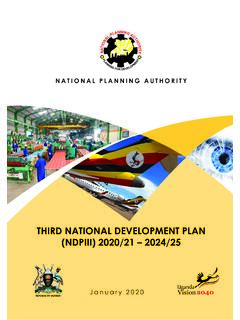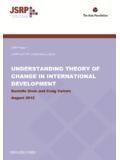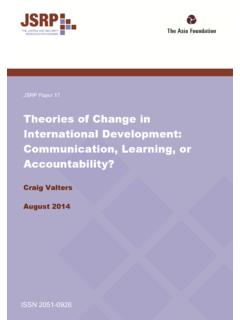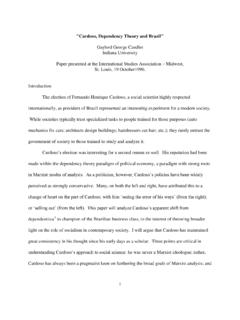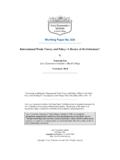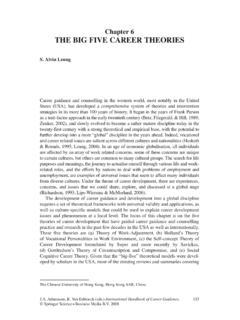Transcription of Theory of Change - Home- Austrian Development …
1 Methodological Briefs Impact Evaluation No. 2 Theory of Change Patricia Rogers UNICEF OFFICE OF RESEARCH The Office of Research is UNICEF s dedicated research arm. Its prime objectives are to improve international understanding of issues relating to children s rights and to help facilitate full implementation of the Convention on the Rights of the Child across the world. The Office of Research aims to set out a comprehensive framework for research and knowledge within the organization, in support of UNICEF s global programmes and policies, and works with partners to make policies for children evidence-based. Publications produced by the Office are contributions to a global debate on children and child rights issues and include a wide range of opinions.
2 The views expressed are those of the authors and/or editors and are published in order to stimulate further dialogue on impact evaluation methods. They do not necessarily reflect the policies or views of UNICEF. OFFICE OF RESEARCH METHODOLOGICAL BRIEFS UNICEF Office of Research Methodological Briefs are intended to share contemporary research practice, methods, designs, and recommendations from renowned researchers and evaluators. The primary audience is UNICEF staff who conduct, commission or interpret research and evaluation findings to make decisions about programming, policy and advocacy. This brief has undergone an internal peer review. The text has not been edited to official publication standards and UNICEF accepts no responsibility for errors.
3 Extracts from this publication may be freely reproduced with due acknowledgement. Requests to utilize larger portions or the full publication should be addressed to the Communication Unit at To consult and download the Methodological Briefs, please visit For readers wishing to cite this document we suggest the following form: Rogers, P. (2014). Theory of Change , Methodological Briefs: Impact Evaluation 2, UNICEF Office of Research, Florence. Acknowledgements: This brief benefited from the guidance of many individuals. The author and the Office of Research wish to thank everyone who contributed and in particular the following: Contributors: Greet Peersman Reviewers: Nikola Balvin, Roberto Benes, Fiachra McAsey, Gustave Nebie 2014 United Nations Children s Fund (UNICEF) September 2014 UNICEF Office of Research - Innocenti Piazza SS.
4 Annunziata, 12 50122 Florence, Italy Tel: (+39) 055 20 330 Fax: (+39) 055 2033 220 Methodological Brief : Theory of Change Page 1 1. Theory OF Change : A BRIEF DESCRIPTION A Theory of Change explains how activities are understood to produce a series of results that contribute to achieving the final intended impacts. It can be developed for any level of intervention an event, a project, a programme, a policy, a strategy or an organization. A Theory of Change can be developed for an intervention: where objectives and activities can be identified and tightly planned beforehand, or that changes and adapts in response to emerging issues and to decisions made by partners and other stakeholders.
5 Sometimes the term is used generally to refer to any version of this process, including a results chain, which shows a series of boxes from inputs to outputs, outcomes and impacts (see figure 1), or a logframe, which represents the same information in a matrix. Schematic depiction of a Theory of Change , Peer Review Group meeting Figure 1. Source: United Nations Children s Fund, Supplementary Programme Note on the Theory of Change , Peer Review Group meeting, 11 March 2014, UNICEF, New York, 2014, p. 4. See Methodological Brief : Theory of Change Page 2 Theory of Change for multi-country evaluation on increasing access and equity in Figure childhood education Source: UNICEF Regional Office for Central and Eastern Europe and the Commonwealth of Independent States (2014) Terms of Reference for Multi-country evaluation on increasing access and equity in early childhood education: UNICEF s contribution to achieving results in six CEE-CIS countries, 2005 2012, p.
6 7. Other times it is used to refer to specific types of representations especially those that provide more detail about different levels of Change , different actors and different causal pathways (see figure 2). Sometimes these representations show the contextual factors that help or hinder this Change , and the assumptions on which it is built (conditions which are necessary for it to work but which are not under the control of implementers). This brief discusses the concept of Theory of Change in the broader sense of the term, while recognizing that it is sometimes defined more narrowly. A Theory of Change can be used for strategic planning or programme/policy planning to identify the current situation (in terms of needs and opportunities), the intended situation and what needs to be done to move from one to the other.
7 This can help to design more realistic goals, clarify accountabilities and establish a common understanding of the strategies to be used to achieve the goals. For example, the UNICEF Strategic Plan 2014 2017 is based on a Theory of Change that builds on UNICEF s comparative advantages, and encompasses identifying and scaling up effective technological, scientific and programmatic innovations; improving organizational capacity for the implementation of policies and national laws; developing the capacities of children, families and communities to act as agents of Change ; and working in national and global partnerships. A Theory of Change can also be used during implementation to identify which indicators must be monitored, and to explain to staff, funders and partners how the programme or policy works.
8 Methodological Brief : Theory of Change Page 3 In an impact evaluation, a Theory of Change is useful for identifying the data that need to be collected and how they should be analysed. It can also provide a framework for reporting. Developing a Theory of Change is not simply a matter of filling in boxes; it is important to ensure that the Theory of Change adequately represents what the intervention intends to achieve and how to the satisfaction of those who will use it. Ideally, a Theory of Change explains how Change is understood to come about, rather than simply linking activities to expected results with an arrow. Main points A Theory of Change explains how activities are understood to contribute to a series of results that the final intended impacts.
9 There are different ways of developing and representing a Theory of Change . 2. In an impact evaluation, the existing Theory of Change should be reviewed and revised as needed guide data collection, analysis and reporting 2. WHEN IS IT APPROPRIATE TO USE A Theory OF Change ? A Theory of Change is a building block for impact evaluations and should be used in some form in every impact evaluation. It is particularly useful when the intention is to learn from an impact evaluation conducted at one site and then apply these lessons to another site. When planning an impact evaluation and developing the terms of reference, any existing Theory of Change for the programme or policy should be reviewed for appropriateness, comprehensiveness and accuracy, and revised as necessary.
10 It should continue to be revised over the course of the evaluation should either the intervention itself or the understanding of how it works or is intended to work Change . 3. HOW TO DEVELOP A Theory OF Change A Theory of Change should begin with a good situation analysis. This involves identifying: the problem that the intervention seeks to address; the causes and consequences of this problem; and the opportunities, for example, synergies with other initiatives, or existing resources that can be leveraged or strengthened. Even in situations where the Theory of Change is being developed or significantly revised well after implementation has commenced, it is important to review the situation that gave rise to the intervention to ensure that the intervention is attempting to solve the right problem.
